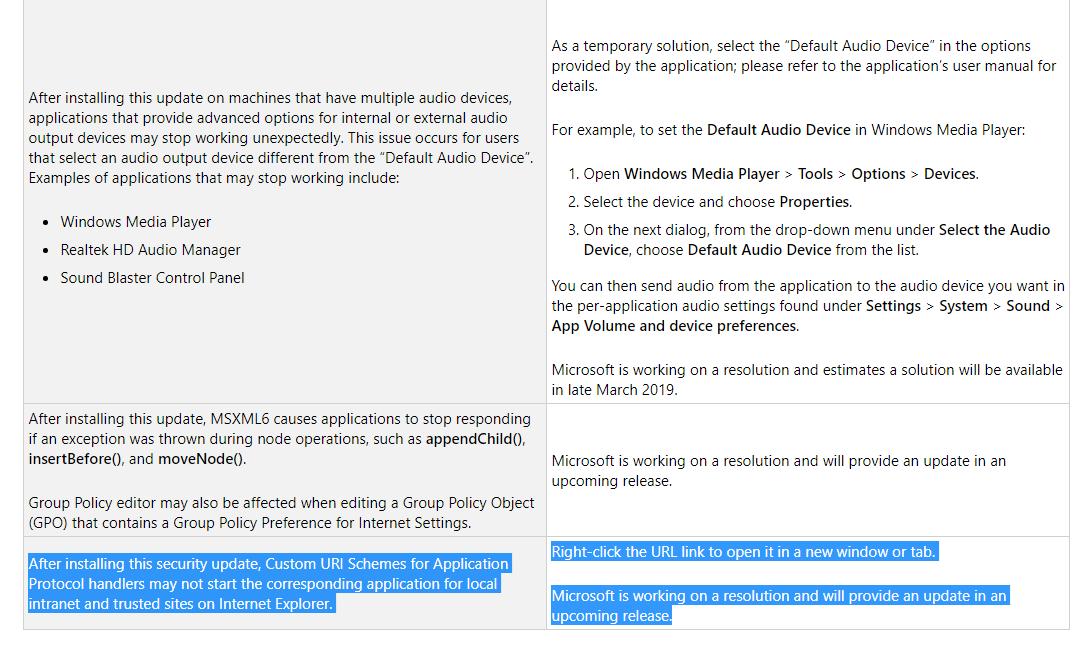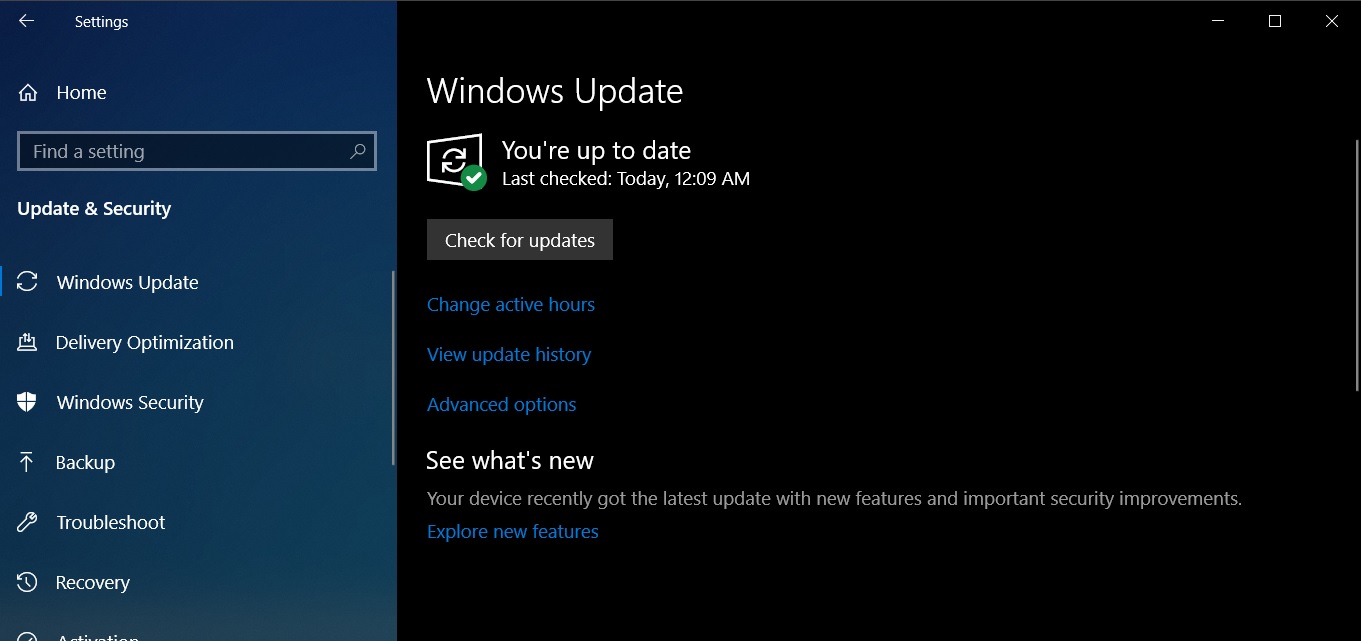Windows Start Not Working After Update March 2019
Microsoft is one step closer to releasing the Windows 10 April 2019 Update after game developers issue fixes for an anti-cheat bug that has been plaguing Windows 10 insider builds for some time.In an to the Windows 10 Insider Preview Build 18362 announcement page, Microsoft has stated that game developers have released a fix for anti-cheat software bug that has been causing Windows machines to crash with Green Screen of Death (GSOD) errors.' Launching games that use anti-cheat software may trigger a bugcheck (GSOD). UPDATE 3/28: Many games that use anti-cheat software have released fixes for the issue causing PCs to bugcheck (GSOD). The upgrade block that prevents Windows Insiders from updating to the latest build will be removed soon.' Since as early as, popular games that utilize anti-cheat software have been causing Windows 10 Insider builds to crash with GSOD errors as shown below. It appears that this was a bug that needed to be fixed on the game side rather than Windows.
- Windows Start Not Working After Update March 2019 Date
- Windows 10 2019 Update
- New Windows Update 2019 Download

Jun 4, 2019 - Microsoft Delivers Intel Microcode Updates for Windows 10 Variants. KB4497936 Breaks Windows Sandbox, Fix Might Come in June. Windows Sandbox may fail to start with error code “0x80070002” Windows Sandbox may fail to. Non-security Microsoft Office Updates for May 2019 Now Available. The Windows start button is not working. When I press it nothing happens. SO I cannot shut down the computer in the normal manner or access any programs other than ones with desktop icons. Computer/PC Freezes Windows 10 Fix (June 2019 Update). Open the Start Menu and the type commend prompt in the Start Menu's search box. Right-click on.
Windows Start Not Working After Update March 2019 Date
Now that it has been resolved, it clears one more hurdle to the release of the Windows 10 April 2019 Update.At this point, there is still one more bug related to X-Fi sound cards that Microsoft needs to resolve before pushing the next feature update out.The good news is that the latest Windows 10 Insider Build 18865 from the 20H1 branch indicates that a resolution is in sight. According to, Microsoft has been working with Creative to resolve the bug and new fixed drivers have been released for some X-Fi models.' Creative X-Fi sound cards are not functioning properly. Creative has released updated drivers for some affected X-Fi sound cards. Please refer to Creative’s website for details on your particular hardware and any available updates.'
Once the X-Fi issue is resolved, we should expect the Windows 10 April 2019 Update to be released.
Windows Server 2019 Activation. 6/7/2019. 6 minutes to read. Contributors.In this articleApplies To: Windows Server 2019, Windows Server 2016The following information outlines initial planning considerations that you need to review for Key Management Services (KMS) activation involving Windows Server 2019. For information about KMS activation involving operating systems older than those listed here, see.KMS uses a client-server model to active clients. KMS clients connect to a KMS server, called the KMS host, for activation. The KMS host must reside on your local network.KMS hosts do not need to be dedicated servers, and KMS can be cohosted with other services.

You can run a KMS host on any physical or virtual system that is running Windows 10, Windows Server 2019, Windows Server 2016, Windows Server 2012 R2, Windows 8.1, or Windows Server 2012.A KMS host running on Windows 10 or Windows 8.1 can only activate computers running client operating systems.The following table summarizes KMS host and client requirements for networks that include Windows Server 2016, Windows Server 2019 and Windows 10 clients. Note. Updates might be required on the KMS server to support activation of any of these newer clients. NoteDepending on which operating system your KMS server is running and which operating systems you want to activate, you might need to install one or more of these updates:. Installations of KMS on Windows 7 or Windows Server 2008 R2 must be updated in order to support activation of clients running Windows 10. For more information, see.
Installations of KMS on Windows Server 2012 must be updated in order to support activation of clients running Windows 10 and Windows Server 2016 or Windows Server 2019, or newer client or server operating systems. For more information, see. Installations of KMS on Windows 8.1 or Windows Server 2012 R2 must be updated in order to support activation of clients running Windows 10 and Windows Server 2016 or Windows Server 2019, or newer client or server operating systems.
For more information, see. Windows Server 2008 R2 cannot be updated to support activation of clients running Windows Server 2016, Windows Server 2019, or newer operating systems.A single KMS host can support an unlimited number of KMS clients. If you have more than 50 clients, we recommend that you have at least two KMS hosts in case one of your KMS hosts becomes unavailable. Most organizations can operate with as few as two KMS hosts for their entire infrastructure. Addressing KMS operational requirementsKMS can activate physical and virtual computers, but to qualify for KMS activation, a network must have a minimum number of computers (called the activation threshold). KMS clients activate only after this threshold is met.
To ensure that the activation threshold is met, a KMS host counts the number of computers that are requesting activation on the network.KMS hosts count the most recent connections. When a client or server contacts the KMS host, the host adds the machine ID to its count and then returns the current count value in its response.
The client or server will activate if the count is high enough. Clients will activate if the count is 25 or higher.
Servers and volume editions of Microsoft Office products will activate if the count is five or greater. The KMS only counts unique connections from the past 30 days, and only stores the 50 most recent contacts.KMS activations are valid for 180 days, a period known as the activation validity interval. KMS clients must renew their activation by connecting to the KMS host at least once every 180 days to stay activated. By default, KMS client computers attempt to renew their activation every seven days. After a client’s activation is renewed, the activation validity interval begins again. Addressing KMS functional requirementsKMS activation requires TCP/IP connectivity. KMS hosts and clients are configured by default to use Domain Name System (DNS).
Windows 10 2019 Update
By default, KMS hosts use DNS dynamic update to automatically publish the information that KMS clients need to find and connect to them. You can accept these default settings, or if you have special network and security configuration requirements, you can manually configure KMS hosts and clients.After the first KMS host is activated, the KMS key that is used on the first host can be used to activate up to five more KMS hosts on your network. After a KMS host is activated, administrators can reactivate the same host up to nine times with the same key.If your organization needs more than six KMS hosts, you should request additional activations for your organization’s KMS key—for example, if you have ten physical locations under one volume licensing agreement and you want each location to have a local KMS host. NoteTo request this exception, contact your Activation Call Center. For more information, see.Computers that are running volume licensing editions of Windows 10, Windows Server 2019, Windows Server 2016, Windows 8.1, Windows Server 2012 R2, Windows Server 2012, Windows 7, Windows Server 2008 R2 are, by default, KMS clients with no additional configuration needed.If you are converting a computer from a KMS host, MAK, or retail edition of Windows to a KMS client, install the applicable KMS Client Setup Key.
New Windows Update 2019 Download
For more information, see.